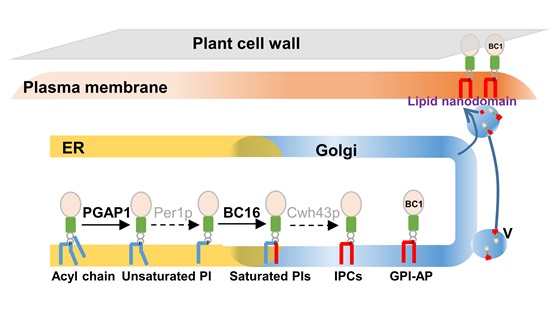
GPI O-acyltransferase regulates plant mechanics. (Image by IGDB)
Glycosylphosphatidylinositol (GPI) anchoring is an important post-translational modification, which tethers non-transmembrane proteins to the outer leaflet of the plasma membrane (PM), to participate in many biological processes via facilitating signal perception, cell adhesion, transportation, and metabolism. Mature GPI moieties of eukaryotes usually contain a conserved glycan core structure and a variable lipid tail, and the lipid portion is important for targeting GPI-anchored proteins (GPI-APs) to the destined places at cell surface. The differences in lipid structure hence indicate varied sorting pathways for GPI-APs. GPI lipid synthesis involves multi-step remodeling reactions, which convert unsaturated fatty acid chains to saturated lipids and ultimately form varied lipid tails in yeast and animals.
Plants have around 300 GPI-APs. Of multiple biological functions, assembly of plant cell wall is proposed one of their key roles. However, the mechanisms of GPI modification, especially lipid remodeling, and the roles in cell wall organization are still rather unclear.
Researchers led by Prof. ZHOU Yihua from the Institute of Genetics and Developmental Biology of the Chinese Academy of Sciences (CAS) recently reported that BRITTLE CULM16, a glycosylphosphatidylinositol anchor lipid remodelase, is required for targeting modified proteins to the cell surface and governs cell wall biomechanics.
Through characterization of rice brittle culm 16 (bc16) mutant, BC16 was identified to encode a membrane-bound O-acyltransferase (MBOAT) in GPI lipid remodeling and co-expressed with many GPI-forming genes. BC16 is located in the endoplasmic reticulum and the Golgi apparatus.
By introduction of BC16 into a yeast mutant deficient in a MBOAT homolog, growth defect of the yeast mutant was fully rescued and the lipid structure abnormalities in GPI-APs were largely restored. Mass spectrometry analysis of rice GPI-AP lipids revealed that saturated phosphatidylinositol and phosphatidylceramide are the major GPI lipid composition in plants, and those are greatly reduced in the bc16 mutant.
Using BC1, a known GPI-AP involved in secondary cell wall formation, and several GPI-APs as reporters, BC16-mediated lipid remodeling was demonstrated required for targeting GPI-APs to specific microdomains at the PM. Interestingly, cellulose synthase CESA4 likely also locates in such PM microdomains, providing critical evidence for the BC16 function in cell wall formation.
Furthermore, atomic force microscopy and nanoindentation analysis revealed abnormal alignment of cellulosic nanofibrils in bc16, similar to those in bc1, which result in altered elastic moduli and a decreased mechanical strength.
This work is the first to explain crop brittleness from a biomechanical perspective.
Therefore, this study provides novel insights into the maturation of plant GPI lipids and outlines a mechanism for governing cell wall mechanics and plant mechanical strength, offering a tool for molecular design of elite crops with optimal supporting strength.
This research was supported by the Strategic Priority Research Program of CAS, the National Natural Science Foundation of China, the Youth Innovation Promotion Association of CAS, and the State Key Laboratory of Plant Genomics.





